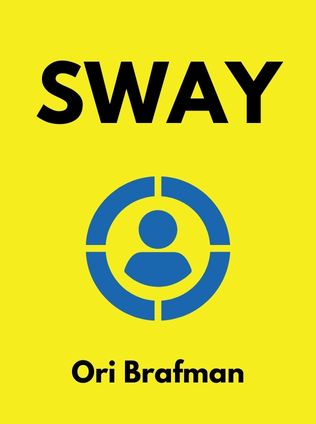
Sway
The Irresistible Pull of Irrational Behavior
By Ori Brafman,
Published 08/2021
About the Author
Ori Brafman is a distinguished author and expert in organizational dynamics, leadership, and change management. He has been instrumental in exploring how organizations can adapt and thrive in a rapidly changing world. With a background in business and a master’s degree from the London School of Economics, Ori brings a unique perspective to his work. He co-authored "The Starfish and the Spider," which explores decentralized organizations' resilience and adaptability. Ori’s insights are sought after by Fortune 500 companies, governmental agencies, and military institutions, making him a prominent figure in the field of organizational behavior.
Rom Brafman complements Ori’s expertise with his deep understanding of psychology. Holding a Ph.D. in personality and personal growth, Rom has dedicated his career to studying the intricacies of human behavior. He has taught at the university level, sharing his knowledge on topics such as personality development and the psychological underpinnings of decision-making. Together, the Brafman brothers offer a comprehensive look at the factors influencing human behavior, blending insights from psychology and organizational theory.
Main Idea
"Sway: The Irresistible Pull of Irrational Behavior" is a compelling exploration of the psychological forces that often lead us astray from rational thinking. Ori and Rom Brafman delve into how these forces manifest in various aspects of our lives, from personal decisions to professional interactions. The central thesis of the book is that despite our belief in our rationality, we are frequently influenced by subconscious biases and irrational tendencies. By understanding these forces, we can become more aware of their impact and make more informed, rational decisions. The Brafmans argue that recognizing these "sways" is crucial for personal growth and effective decision-making in all areas of life.
Table of Contents
- Introduction
- Dealing with Loss
- The Swamp of Commitment
- Value Attribution
- The First-Date Interview
- The Chameleon Effect
- What's Fair is Fair
- Motivation Through Compensation
- Dissenting Justice
- Epilogue
Dealing with Loss
The phenomenon of loss aversion is a cornerstone of the book. This psychological bias refers to the tendency for people to prefer avoiding losses rather than acquiring equivalent gains. In other words, the pain of losing is psychologically twice as powerful as the pleasure of gaining. The Brafmans explore how this bias manifests in various situations, influencing our decisions and behaviors in significant ways.
For example, the book discusses the research of Professor Daniel Putler, who observed that consumers are much more sensitive to price increases than to price decreases. This asymmetry in consumer behavior highlights how the fear of loss can drive irrational actions, such as drastically reducing purchases in response to minor price hikes. The authors use this example to illustrate how deeply ingrained loss aversion is in our psyche, often leading us to make decisions that are not in our best interest.
“We experience the pain associated with a loss much more vividly than we do the joy of experiencing a gain.” - Ori and Rom Brafman
Another striking example involves investment decisions. The Brafmans recount the story of a client of Jordan Walters, a financial advisor, who refused to sell a declining stock because he couldn’t bear to realize a loss. This client exemplified the tendency known as "chasing a loss," where individuals continue to invest in a losing proposition in the hopes of breaking even, often resulting in even greater losses.
loss aversion include:
- An investor holding onto a declining stock rather than selling it to prevent further losses, hoping the value will rebound.
- Shoppers overreacting to price increases by cutting back more drastically than they would increase consumption when prices drop.
- Individuals sticking with a failing project due to the significant time and resources already invested, rather than cutting their losses and moving on.
This discussion reveals that loss aversion is not just a quirk of human psychology but a powerful force that can shape our lives and decisions in profound ways.
The Swamp of Commitment
The swamp of commitment is another key concept explored in the book. This refers to the difficulty people face in abandoning a course of action, even when it becomes clear that it is not yielding the desired results. The Brafmans describe how commitment, combined with loss aversion, can trap individuals and organizations in a cycle of poor decision-making.
One vivid illustration of this is the "$20 auction" experiment conducted by Max Bazerman. In this experiment, participants are encouraged to bid on a $20 bill, with the twist that the second-highest bidder must also pay their bid but receives nothing. The auction typically escalates beyond the bill's actual value as bidders become increasingly committed to not losing, demonstrating the irrational escalation of commitment and the power of loss aversion.
Sign up for FREE and get access to 1,400+ books summaries.
You May Also Like
The Subtle Art of Not Giving a F*ck
A Counterintuitive Approach to Living a Good Life
By Mark MansonRich Dad Poor Dad
What the Rich Teach Their Kids About Money - That the Poor and Middle Class Do Not!
By Robert T. KiyosakiHow To Win Friends and Influence People
The All-Time Classic Manual Of People Skills
By Dale CarnegieFreakonomics
A Rogue Economist Explores the Hidden Side of Everything
By Steven D. Levitt and Stephen J. Dubner



















